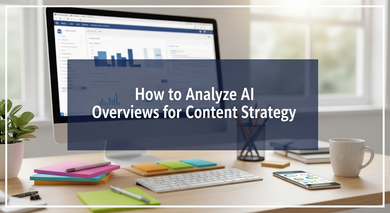With more prominence in the digital world given to search features powered by AI, such as the Google AI Overviews, content providers and marketing professionals will soon be confronted by another common issue: How do we change our tactics for what the AI displays? Perhaps the key lies in understanding and analyzing AI Overviews that are provided by AI as a summary at the top of the search results and using such learnings for your content creation.
Let us delve deeper into how analyzing AI Overviews will sharpen your content strategy in 2025.
What Are AI Overviews?
An AI overview is a brief AI-generated answer presented by search engines (like Google) to sum up responses to user queries. Pulled from multiple sources, these overviews aim to give the user the best possible answer without having to scroll through multiple links.
While AI Overviews were meant to improve the user experience, they also changed the dynamics of visibility and engagement. Businesses must now optimize content not only for traditional SEO but also for interpretation by AI.
Why AI Overviews Matter for Content Strategy
Reviewing AI Overviews has the potential to fetch some insight into what sort of content an AI actually finds valuable, and hence shows to the user. Here’s why they are critical:
They Shape the Search Behavior
AI Overviews often appear before organic results, particularly for informational and how-to queries. If your content does not align with these summaries, you risk being disregarded.
They Establish an Authority Hierarchy
By analyzing sources and structure of AI Overviews, one can actually make out an outline of what authoritative and good quality content looks like in the perception of AI systems.
They Call for Straightforward Answers Targeted Towards User Intent
This puts the content creator in the sincere position of answering real questions instead of stuffing keywords or wordy wishlist-style.
How to Analyze AI Overviews: Step-by-Step
Identify Target Queries
Start by searching for core keywords or questions your audience typically asks. Check what the AI returns on AI-appointed search engines such as Google (with SGE enabled) and Bing.
Example: Search “how to reduce website bounce rate” and take note of the AI Overview content.
Content Format and Structure
Look at the way the answer is presented:
- Does it consist of a bulleted list? Is it a step-by-step process or a definition of terms?
- Is there a statistic, a figure, or a cited example in it?
- Are the language and style precise, simple, and authoritative?
This will help you understand which format to follow in your content.
Track the Cited Sources
Find out which domains are being referenced for this overview. This will tell you:
- Who your content competitors are
- What kind of content does AI seem to trust (blogs, government sites, forums, etc)
- What sorts of authority signals might be affecting AI (domain age, backlinks, and so on)
Assess Topic Coverage
Ask yourself:
- Which subtopics or related questions are included?
- Are there gaps in the AI answer that your content could cover?
- Is there a clearly defined user intent being fulfilled?
Such an analysis will help you to generate the most complete, relevant content for people as well as AI algorithms.
Track over Time
AI Overviews are not static. Regularly revisit the same queries to look for:
- Content updates or changes in tone
- New competitors
- Changes in content length, formatting, or sources.
Use this information to constantly evolve your content strategy.
Content Optimization According to AI Overview Analysis
Answer Directly and Early
Put the most important answer or summary in the first 1-2 sentences of the content. The AI is skeptical of where the concise answer is presented and quickly grabs it.
Use Clear Formatting
Build H2/H3 headings, bullet points, and short paragraphs for readability and scannability—attributes that an AI considers.
Add Structured Data
Give search engines (and AI models) a representation of your content by applying schema markup.
Build Topical Authority
Cover clustered topics to portray deep expertise offered by a website and not just a single page.
Include Expert Sources
Cite data, case studies, and expert opinions to help with the website’s credit and chances of being cited in AI summaries.
From Insight to Execution: Turning Analysis Into Action
With the AI Overviews for your niche in hand, start applying your findings:
- Update any existing content to adhere to a more AI-friendly format or tone.
- Tell a story with new content, filling in gaps or providing more depth on what has surfaced.
- Check content performance over time using Google Search Console and other analytic tools to determine whether impressions have gone up.
Final Thoughts: Stay Ahead of the Curve
Analyzing AI Overviews is not only a technical exercise but also a tactical advantage. As we go deeper into an AI-first search era, businesses that learn how to read and what needs to be displayed by AI will win visibility.
Need Help Crafting AI-Optimized Content?
As an experienced digital marketing company, AdsRole LLC helps brands to be future-ready by creating digital strategies that use traditional SEO and the latest Answer Engine Optimization. From structured content to schema implementation, we tailor the message of your brand to fit into changing standards of AI-based search.
Contact us today to unlock smarter content strategies and greater online visibility.


